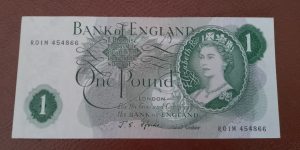British banknotes, paper money, has a long history dating back to 1695, the year after the founding of the Bank of England. Scottish banking history shares the same date of origin but was not established in a state funding role unlike the Bank of England. Over the centuries, banknotes have developed in face value even though for most people until 1914, banknotes were rarely seen or used.
It was after the outbreak of WW1 banknotes were produced with lower values, 10/- and £1. These are ‘Treasury Notes’, signed by the Chief Cashier of the Bank of England, John Bradbury. ‘Bradburys’ and ‘Warren Fisher’ notes are very collectible. Some notes are rare and of great value. Collectors of British banknotes are attracted by their design, rarity, currency history and can be seen also as an investment.
For most, it is an interest, focussing upon a particular area such as Treasury Notes, White Banknotes, Replacement Notes, Experimental Notes, Errors, Low serial numbers, Debdens, First and Last runs. Amongst the British and World banknotes on offer here, I hope you will find banknotes to enhance your collection. Have a look also at the Provincial Notes on offer.as these highlight the proliferation of banks in the 18th and 19th Centuries.
Latest Post
Buying and Selling British Banknotes – The Philosophy of Collections
I studied Philosophy and Metaphysics many years ago at university. To be honest, a lot of it I found dreadfully tedious at the time but now, in later life, I have come to appreciate one of my tutors who always demanded of us – ‘De omnibus dubitandum’. All things must be questioned. His drive was… Read more »







